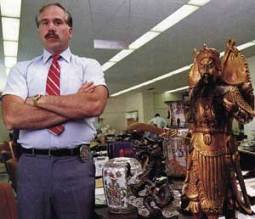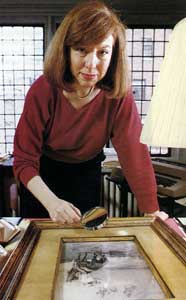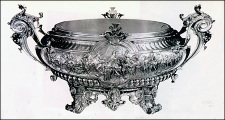Off the Wall: The Global Art Crime Epidemic
By Stephen Brookes
In Washington, DC and New York for Insight Magazine
How easy it is, really, to steal $200 million worth of art. In the early morning hours of March 18, two thieves dressed as policemen talked their way into Boston's Isabella Stewart Gardner Museum, tied up the guards and spent two leisurely hours looting the collection. Picking carefully but oddly, they bypassed a number of superb works and took eleven paintings and etchings by Edgar Degas, Govaert Flinck, Edouard Manet, Rembrandt (including one thought to be a forgery) and Jan Vermeer, as well as a bronze beaker from the Chinese Shang dynasty. None of the artworks was insured. None has been recovered.

Crime victim MonaIn sheer monetary terms it was the most spectacular art theft in history, and it launched a worldwide search that will probably continue for months, if not years or even decades. But the Gardner break-in, for all its drama, was only the latest in what has become a global wave of art thefts and frauds.
“Art crime is up all over the world," says Detective William E. Martin, who heads the Los Angeles Police Department's Art Theft Detail. "There's so much money in art that the criminal element has gotten very much involved." By some estimates, art crime is second only to the international trade in drugs.
The amount of money changing hands in the art world these days is staggering. A self-portrait by Picasso went for $47.85 million last May, van Gogh's "Irises" sold in 1987 for $53.9 million, and Sotheby's auctioned off a 5,000-year-old marble head from the Greek Cyclades for $2.09 million several years ago. Those were the headline-grabbers, but they were only the tip of the iceberg. Millions of lesser artworks are snatched up by affluent collectors and investors every year, and those prices are skyrocketing, too. The international art market, by some estimates, is worth no less than $50 billion a year.
Where that kind of money goes, thieves, forgers and con artists will soon follow. There is nothing new about that, of course: Greed and dishonesty are hardly late 20th century phenomena. But the art market's voracious appetite for new works has made crime a fact of daily life.
Artworks are stolen from museums, from libraries, from private collectors, from galleries; religious icons are taken from churches; ancient artifacts are looted from archaeological sites in Latin America; Buddhist temple carvings are smuggled from Asian villages. The flow is huge and depressingly endless. And only 10 to 12 percent of it is ever recovered.
Almost any kind of art is traded in the vast black market -- even the Mona Lisa was once stolen from the Louvre. (It was recovered two years later, in 1913.) A random look through some of the 32,000 listings of stolen art kept by the International Foundation for Art Research in New York shows just how eclectic the market is: five paintings by Andy Warhol; an etching by the Spanish surrealist Joan Miro; a bronze sculpture by Frederic Remington; an elaborately engraved 17th century silver tankard from Germany; several Ming dynasty Chinese vases; a 19th century Navajo chief’s blanket -- even (in a dramatic burglary in New York last August) a ring said to have belonged to Vlad the lmpaler, circa 15th century.

Det. Martin with stolen artifactsHot art can be bulky and elaborate, like the acrylic, plastic foam and telephone-wire sculpture by the contemporary artist Richard Pousette-Dart that was stolen in New York a year ago. Or it can be tiny and easy to conceal: Hundreds of Japanese netsuke, lacquer boxes and other small objects were missing after thieves broke into the Museum of Japanese Art in Haifa, Israel, last November. There are obvious targets: Works by Rembrandt are always popular (nine engravings were taken in a single burglary last October in Vienna), as are Meissen vases, Greek antiquities and anything by Picasso. Or there are pieces that appeal to more specialized tastes: an 1825 flute made of cut glass and silver that was taken from a New York apartment last year, for example.
The market for any kind of art is so strong, in fact, that thieves are even snatching weather vanes from historic buildings. Three were taken last year, including an 18th century rooster-shaped vane that vanished one August night from a church steeple in Hushing, N.Y.
So where does the art go? Many times, nowhere at all, say experts. Art is often stolen on the spur of the moment, by amateurs: a poorly paid guard left alone at night left alone at night with a room full of treasures who succumbs to temptation, or a truck driver working for an art transport company who "loses" his cargo. Occasionally, a casual visitor to a museum or gallery will simply unhook a small painting on impulse, slip it under his coat and sneak out.
"I've seen very few really professional jobs," says Huntington T. Block, whose Washington-based company insures museums and private collectors across the country. "Generally, they've made the heist and then realize the next morning that they've got a hot potato on their hands and don't know what to do with it."
A few crooks, in fact, are little more than shoplifters. "We had two pieces stolen off the shelf just a month ago," says Ken Bower, owner of a pre-Columbian art gallery in New York called The Lands Beyond. "Three people came in before we could do anything about it, and you could tell right away what they were up to. One here, one over there, picking up expensive pieces, bumping into me. The woman who took the pieces was great - she had a big coat with voluminous pockets, and we lost two things."
Sometimes even professional crooks will abandon what they have taken when they find out it's art: A cache of rare books and prints, worth about $400,000, stolen from a truck en route to a fine art dealer in New York last December was quickly recovered by police in a sidewalk trash bin. The thieves, apparently unimpressed with their haul, had dumped the books almost as soon as they had stolen them.
But others in law enforcement argue that the genre is growing increasingly sophisticated. There are more thieves who specialize in art, they say, and they tend to be a cut above the average crook: They usually inspect their targets beforehand, think the crime through and know how and where to get rid of what they steal.
"The normal burglar doesn't really have a market for art," says Martin. "Why take a big, bulky painting when you don't know what it's worth and don't have a market for it? Most art thieves know what they're going after before they go in; the thief, or the person who sets up the thief, is usually known to the victim or has been in the house."

Grandma Moses: Too famous to fenceThat’s why most investigators dispute the professionalism of the Gardner Museum robbery. The high value and visibility of the stolen works (as well as the fact that some of the paintings were cut out of their frames) have made them impossible to sell, they argue. A real professional knows enough to forgo the most valuable pieces in a collection and take the ones that can be quietly fenced and slipped back into the legitimate market. Thieves who looted the Bennington Museum in Vermont five years ago, for example, took a number of quality pieces of Bennington pottery and antiques but left behind the extremely valuable (and unsalable) collection of Grandma Moses paintings. The haul was recovered at two apparently legitimate antique shops, one in Florida and the other in New York.
Some thieves are con artists, as sharp and sophisticated as they are crooked. Los Angeles police are hunting for one Richard Sebastian Esterhazy, an international art wheeler-dealer who opened an auction house in Hollywood shortly after arriving in the United States in 1986. He attracted attention early last year, however, when police started receiving complaints that he had never sold works given to him on consignment. As the pressure mounted, Esterhazy suddenly closed down his auction house in April last year and vanished, leaving no trace of the hundreds of works that art sellers had left with him. The dealer, who has a British passport and who speaks several languages fluently, is thought to have fled the country with the missing art.
Along with the professionalism has come a worrying trend toward violence. A daring 1985 robbery of the Mannottan Museum in Paris, in which nine French Impressionist paintings worth an estimated $12.5 million were lost, was done "with military precision," says Charles Koczka, a former U.S. Customs official turned private art investigator. "They came in, in the middle of the afternoon, putting guns to people's heads. And in less than 10 minutes they stole the creme de la creme of the collection. I almost have to believe it was a former military group: They timed it perfectly, so they were gone before the nearest police could arrive. And they knew exactly what to take."
In another brutal robbery last August, two men dressed as policemen arrived at the apartment of a New York art restorer named Vlaicu Ionescu with a painting they wanted him to identify. As Ionescu started to unwrap the package, the men pulled out guns and shoved him back into the apartment. After they beat and handcuffed him, the thieves leisurely took 40 paintings (together with their authentication documents) worth about $4 million. When they told the dealer they had been paid $50,000 to steal the paintings, lonescu offered to pay them more to go away. The crooks refused point-blank, Ionescu related. "They said their families were in danger."
Stories like that have led to suspicions that organized crime groups and possibly drug trafficking organizations are involved. Forty-four persons, including the alleged boss of the Calabrian Mafia, Antonino Saraceno, were indicted in Italy last September for alleged involvement in a drug-smuggling ring financed with kidnappings and art thefts. And writer Peter Watson relates in his 1985 book, "The Caravaggio Conspiracy," that Italian art smugglers would sometimes put heroin into the frames of stolen paintings when they shipped them from Sicily to the United States. Watson's book revolves around his efforts to track down the Caravaggio painting 'Adoration of the Shepherds," whose theft from a Palermo church in 1969 was allegedly ordered by the Mafia.
"There's a lot of conjecture, because of the huge profits the major drug dealers are raking in these days and the fact that many of them do develop ostentatious, luxurious life-styles as a result," says FBI agent James Lile, who oversees the bureau's stolen art file. "From past experience, I know that in organized crime a facade of legitimacy is sometimes attempted through the acquisition of paintings and antiques."
There have been a few isolated cases in which drug dealing and art theft have gone hand in hand. During a renovation of the Detroit Institute of Arts in May 1982, for example, four 17th-century oil paintings were stolen from one of the museum's storage rooms.
The paintings vanished, and it was only early this year that they came to light again - after an art dealer named Anna Bames testified in a drug investigation that she had kept them in storage for drug traffickers in Michigan. According to the FBI, the paintings were to be used as collateral in a major cocaine shipment from Miami to Detroit.

IfAR's Constance Lowenthal“Stolen art can be used by the drug trade or anybody who wants to launder money, but we don't have much evidence yet," says Constance Lowenthal, executive director of the International Foundation for Art Research. "I suspect that if we sent out a request on the police wire to report every case where drugs and an were found together, we would all of a sudden have a lot of documentation."
There may be some drug dealers - or just rich collectors - who have stolen the Renoirs hanging in their bathrooms, but most experts are skeptical that art thefts are committed to order, to satisfy the appetite of a sinister buyer. The scenario of a real-life Dr. No, modeled after James Bond's rich, evil and art-loving nemesis, is as cartoonish as the spy novel it comes from, they say.
But in fact, it has happened. A smoothly professional team of thieves finessed the alarm system at Hungary's Budapest Museum of Fine Arts in 1983 and made off with several Italian Renaissance masterpieces, including a self-portrait by Raphael. Investigators traced the thieves back to their native Italy, and the paintings were located in Greece -- a wealthy olive oil baron had engineered the whole operation to add to his private collection.
More recently, vague rumors have been floating around that a "Tokyo Connection" for stolen art has emerged, but that may reflect envy of Japanese buying power more than anything else. One Japanese collector, Shigeki Kameyama, bought a $26.4 million Picasso and a $20.68 million de Kooning (setting a record for a work by a living artist) in the space of two weeks last year. American and European dealers like to sniff that there is little real appreciation for Western art in Japan; Tokyo's new taste for collecting, they say, is pure business.
But whether there is a market across the Pacific for hot masterpieces is another story. Certainly the conditions are there: Money is plentiful (Tokyo is home to several powerful and well-entrenched organized crime groups with international connections), and art recovery laws are thin (after two years, the buyer of a work of stolen art can keep it, even if the rightful owner steps forward). That makes Japan potentially one of the world's best havens for stolen art.

Impression, Soleil LevantOne painting stolen in the Marmottan Museum theft, Claude Monet's "Impression, Soleil Levant" -- a painting of incalculable historic value -- reportedly has been traced to Tokyo's high-priced Ginza district but has not been recovered. And some paintings by Jean-Baptiste-Camille Corot stolen in France in 1988 were recovered recently in Japan.
Still, knowledgeable observers say that the Tokyo Connection is probably a myth. "It would be hard for me to believe that a Japanese businessman with means and social standing will want to exhibit on his walls a painting that he knew was stolen in New York three years before," says art insurer Block.
If a crook does not have a private buyer waiting, he generally has two choices: either move the art out of state (or out of the country) or warehouse it for a long time while the trail cools. "Unless the case is wrapped up relatively quickly, these things can fade away and be gone for many, many years," says Lile. "It's not at all unusual for stolen artworks to be missing for a hundred years before they surface. They're out there circulating and changing hands sub rosa within a particular slice of the culture."
Fencing art can be a lot of trouble, but it can be done. Most stolen art is taken far from the area where it was stolen, often all the way across the country, where it will be sold to a dealer who may or may not know that the work is hot. The going rate? It used to be about 10 cents on the dollar, but investigators say that with the boom in art crime the price has dropped to about a penny on the dollar.
The more legitimate the work appears, the more it is worth, so sophisticated art thieves will increase the value of a stolen work by laundering it through an auction house. It is a simple process: The crook gives the hot art to an auction house, then has an accomplice bid on it and buy it. That gives the thief a bill of sale -- apparent legitimacy -- while costing him only the commission to the auctioneer.

The suspect punch bowlOnce a stolen work is into the stream of commerce, it can be passed on to unwitting, honest dealers. But the initial purchasers are rarely innocents. "There was a theft in November 1988 of a very large, heavy American 19th century silver punch bowl, almost a yard wide," recalls Lowenthal. "Eventually it was sold at Sotheby's for $77,000, but they were able to stop delivery and trace it back. It turned out that the person who bought it from the thief paid only $700 for it. Now, anybody would know that it was worth more than that so the first buyer could not have been lily-white."
A lot depends on how well the piece can fade into the crowd, so to speak. "Masterpieces are very difficult to put into the stream of commerce, but a 19th century landscape really shouldn't pose that many problems," says Lowenthal. "It's not distinct or expensive or well-publicized."
Just such a case occurred in mid-1988. After inheriting a grimy painting from a neighbor, Washington resident Margherita Candeloro gave it to art restorer James R. Austin to clean. That was the last she saw of it for more than a year; while putting Candeloro off with excuses, Austin sold the painting (a landscape by the 19th century American artist Thomas Moran) to a Washington dealer for $15,000 and gave Candeloro a photograph of the work (touched up with a little paint) in return.
By the time she noticed the switch and called the police, the painting had changed hands three more times. When recovered in a California gallery, it was sporting a price tag of $125,000. Austin, who pleaded guilty, was sentenced in early April to pay $40,000 to the people who had bought the painting and to serve a light jail term.
Really top-quality pieces are sometimes smuggled abroad, says Detective Martin, to countries where stolen art can be laundered through legal loopholes. Big deals are often cut in Geneva, because Swiss law allows a buyer to keep a stolen artwork if he bought it "in good faith." And the traffic of both legal and illegal art is encouraged by nearly nonexistent import controls. "I've shipped [licit] materials to France, and it goes by way of Switzerland," says art dealer Bower. "It just breezes in."
There are hundreds of techniques for moving stolen art across borders, from the classic false-bottomed bag to using diplomats as couriers. "We get people in here who bring things they've smuggled out of their country, and they're mostly government officials," confides one American antiquities dealer. "There was one member of a South American government who had a briefcase full of envelopes of gold [artifacts], and on each envelope was the name of the government official it belonged to. And the prices he was asking were about double retail. He probably went on to Europe, where you can get much better prices and there are no questions asked."
Museums are offered stolen works as well, but most go over the background of any prospective purchase with a fine-tooth comb. The Smithsonian Institution in Washington, for example, will not purchase any work that does not have proof of ownership and a researched history, including proof that the object was exported legally from its source country.
Museums in the United States have become especially wary of buying antiquities since a ruling last year by an Indianapolis court that some mosaics stolen from a Cyprus church and smuggled out more than a decade ago had to be returned to the Cypriot government. The decision, which cost the American dealer who had bought the mosaics more than $1 million, has shaken museums' traditional complacency about the origin of their objects.
"The decision put the museum buying community on guard," says Gary Vikan, a curator at the Walters Art Gallery in Baltimore, who testified as an expert witness in the case. "If you're going to buy something, buy it with your eyes open. Make sure you know everything that's going on. And don't believe anybody's story."

Vikan: Don't believe anyone's storyBut often stolen works are not resold at all. Instead, the thieves will contact the owners and offer to return the works -- for a fee,naturally Collectors and galleries are particularly susceptible to this kind of ploy, since many prefer to keep themselves out of the police blotter.
Museums get held for ransom too. Dutch police were stymied at first by the theft of three van Goghs, worth an estimated $90 million, from the Kroller-Muller Museum in the small town of Otterlo in December 1988 -- a smoothly professional heist that left no clues. But the huge amount of publicity generated by the robbery spooked the thieves; realizing that they could never sell the paintings, they demanded a $2.2 million ransom to turn them over. But kidnapping, even of inanimate canvases, is a risky business; the police tripped them up and got the art back.
Sometimes profit is not the motive at all. "There was an unusual case in Australia a couple of years ago, where an art group stole a Picasso to highlight the need for a bigger arts budget," says Lowenthal. "They held the Picasso hostage and demanded that the media give them airtime to put their views forward. The Picasso was returned safety, and it sounds kind of harmless. But we need it like a hole in the head."
That kind of “art terrorism” is not always so benign. Members of the Irish Republican Army broke into the country home of Sir Alfred Beit in 1974, stealing more than a dozen paintings that had been earmarked for the national collection. The thieves said they would return the paintings only if a number of IRA prisoners in Britain were released. But the thieves were quickly caught, and the paintings were returned safely after a little more than a week. (The house was robbed again in 1986, however, and many of the same paintings - including works by Vermeer, Goya, Rubens and Gainsborough, valued at some $40 million were stolen. Most are still missing.)
There may not be any foolproof way for mild-mannered museums to protect themselves from groups as determined as the IRA. Most museums are extremely secure, but in the wake of the Gardner robbery, many are taking a new look at their security, especially at raising the quality of the guards they hire and the training they give them. Raising the status of the job, say some security experts, is the key to preventing more Gardner-type thefts.
But not everyone is convinced. "You might be able to hire high-priced policemen who know a lot about the criminal mind, but how interested are they going to be in standing for eight hours on a stone floor in front of an object, day after day'?" asks private investigator Koczka. "It can't be very exciting.”
And who, it is fair to ask, will guard the guards? When Pablo Picasso's granddaughter Marina was robbed last year of 12 works worth about $17 million, two of her security guards were charged. And a guard at Baltimore's Walters gallery named Gregory Steven Bartgis pleaded guilty last year to stealing about $1 million in Oriental art. Over the course of several months Bartgis had been taking small objects out of display cases, then rearranging them so that nothing was obviously missing.
"He was a funny character, very intelligent," says Walters curator Vikan. "He worked the night shift, and I used to pass him as he was on his way home and I was on my way in every morning. He had a backpack, and I'd often see him wearing it home. We just never really thought anything about it."
Replacing human guards with electronic ones can be equally problematic. It is possible to attach an alarm to every piece in a gallery or private collection, but that makes every installer of security systems a potential criminal. Ohio police last year arrested a security alarm salesman named Jacob Schott, who stole art for five years in the Cincinnati area. Schott would keep either keys or code numbers to alarm systems that he sold, then find out when clients were going to be out of town. When the owners were gone, he would come around with two accomplices, disarm the security system and loot the house.
Even when honestly installed, security systems do not always get high marks from the people who depend on them. "I don't think there's a gallery anywhere that hasn't had a security review in the last five years, but the security services currently available are not that great," complains Donna Carlson, director of administration at the Art Dealers Association of America. "Galleries pay for security services in order to get their insurance. But if it takes a half hour before someone responds to an alarm, everything is going to be gone."
And once it’s gone, it's really gone. It is generally estimated that a paltry 10 to 12 percent of stolen art ever gets recovered, but even that may be optimistic. 'A lot of the police I know say it's only about 5 percent," says Lowenthal.
Retrieving stolen art is often a matter of equal parts of luck, investigation, patience -- and sometimes a reward, such as the $1 million offered by auction houses Christie's and Sotheby's in the Gardner heist. Some theft victims send off photos of the stolen items to galleries, while others - like the two Pennsylvania collectors who contacted a psychic to locate $500,000 worth of art and antiques stolen last September - try more novel methods.
Sometimes it’s pure luck: Five works by Henri Matisse stolen from the painter's former apartment in Nice last December were recovered a few weeks later when a 24-year-old Frenchman, Frank Cochet, was stopped for a routine traffic check. Police found the works in his car.
But the first step in retrieving stolen art is locating it. There are several listings of stolen art available to investigators: One of the best is kept by a joint venture of Interpol and the Royal Canadian Mounted Police in Ottawa, but of more immediate use to U.S. law enforcement is the FBI's National Stolen Art File. Set up in 1979, the file lists about 6,000 items on two coupled data bases; one has images of stolen artworks recorded on laser discs, while the other has verbal descriptions and details of the theft.
Agent Lile explains. "Let's say an investigator is approached by an informant who says, 'I know a guy who's got a painting he says is a Rembrandt. It's got two women sitting at a table with a bowl of fruit between them.' Now, that isn't much information, but we could use it to search the file and pull up any paintings that match that description. If we found one, but it turned out to be a Matisse, we could provide a picture to the investigator to show the informant. And that way we could locate the potential source of a valuable piece of art."
Not every art theft is automatically reported to the FBI, however, and the files are not open to the public. A much more extensive file that anyone can look at is kept by the International Foundation for Art Research, a three-woman team that operates out of the Explorers Club on Manhattan's Upper East Side. Originally set up as a sort of consumer protection aid in the marketplace, the group publishes a monthly art crime magazine called IFAR reports and maintains a listing of about 32,000 records of stolen artworks -- which represents only "the tip of the iceberg," according to Executive Director Lowenthal.
The foundation works with law enforcement agencies and insurance companies to help return stolen works to their owners. "It's an interesting process, almost like catching a fish," says art insurer Block. "You hook them, then slowly reel them in. You want to make it possible for some sort of dialogue to begin, and often a third party will enter the negotiations -- particularly if a reward is involved -- and act as a go-between. But you have to be careful. You don't want to scare them to death so they throw the pictures in the ocean."
But not enough official attention is being focused on art crime, say critics. In contrast to Europe, where art crime is taken seriously and dozens of officials are assigned to the art beat, there are only two law enforcement people in the United States working on art theft full-time, one in New York and the other in Los Angeles.
That means that only the biggest cases really get any attention. "In New York, if you have a work of art stolen that's worth less than $50,000, they'll just put it in the file and no investigation will follow," says private investigator Koczka.
"Isn't it laughable?" asks Donna Carlson. "New York City is the capital of the art world, and there's one police officer assigned to art theft. And he also has to do stolen photographs, stamps, coins, gems, china. It's ridiculous."
In the few cases where the criminals are caught, they usually get light sentences; Juries see art theft as soft, almost victimless crime that afflicts mostly people who can afford it. That makes art theft very nearly the perfect crime. "If you're looking for a criminal activity to get involved in where you can make a fast buck and, if you get caught, not do any hard time," says Koczka, "the art theft industry seems to be it."
(Insight Magazine, May 7, 1990)
References (4)
-
 Response: custom acrylic displaysIn this age of easy Internet purchasing and one-stop shopping, retailers and product merchandisers need to do everything they can to attract shoppers, maintain an edge over competitors and increase the potential for sales. Well designed Acrylic Displays are a good start.
Response: custom acrylic displaysIn this age of easy Internet purchasing and one-stop shopping, retailers and product merchandisers need to do everything they can to attract shoppers, maintain an edge over competitors and increase the potential for sales. Well designed Acrylic Displays are a good start. -
 Response: Best General Physicians in East DelhiFrom common colds to preventative treatment and urgent care, Kailash Deepak Hospital is here to ensure you and your loved ones can get and stay healthy.
Response: Best General Physicians in East DelhiFrom common colds to preventative treatment and urgent care, Kailash Deepak Hospital is here to ensure you and your loved ones can get and stay healthy. -
 Response: Be5 Healthstephen brookes - features - Off the Wall: The Global Art Crime Epidemic
Response: Be5 Healthstephen brookes - features - Off the Wall: The Global Art Crime Epidemic -
 Response: click this over here nowstephen brookes - features - Off the Wall: The Global Art Crime Epidemic
Response: click this over here nowstephen brookes - features - Off the Wall: The Global Art Crime Epidemic


Reader Comments (2)
One question - Which Rembrandt from the Gardner Museum theft was rumoured to be the "forgery?" As opposed to the Rembrandt which was reattributed as a Govaert Flinck. The self portrait?
Bill Tarter
Best, SB